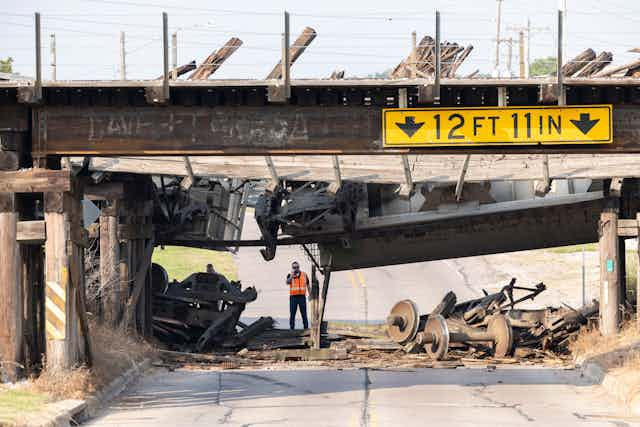On June 24, a train derailment in Montana caused a bridge to collapse, sending hot asphalt and molten sulfur spewing into the Yellowstone River. The derailment came nearly five months after the disastrous derailment near East Palestine, Ohio that raised awareness of rail transportation’s risks and prompted renewed efforts to increase rail safety measures. Here in Canada, we have seen comparable derailments in Ontario, Saskatoon — and the deadly Lac-Mégantic rail disaster in Québec in 2013.
Still, rail companies continue to ignore safety warnings, cut corners on safety measures, and make job cuts.
Notably, most discussions surrounding derailments focus on the impacts to people, minimizing the importance and interconnections of harms to non-human species. However, paying close attention to the harms caused to animals and the environment can create a more accurate picture of damage in a disaster context.
Considering the well-being of humans, animals and the environment can be a valuable approach to a wide range of disaster response plans.
Derailments, still a major problem
Trains are generally regarded as the safest way to transport dangerous goods, and derailments in the U.S. have decreased 44 per cent in the last two decades. However, the U.S. alone still averages about three derailments per day, with many carrying hazardous substances.
Typically, most train derailments do not result in major incidents, though it takes just one to have lasting effects on communities comprised of multiple different species.
Linking human, animal & plant well-being
A deeper picture of harm emerges when viewing the impacts of these disasters through human-animal relationships. People are more likely to evacuate disaster zones if they can find safe passage for their pets, who are often considered members of the family. While losing pets can also add to the trauma that displaced people experience.
A significant population impacted by the East Palestine derailment were pets, while the Columbiana County Humane Society, a registered non-profit organization, was quickly overrun with evacuating animals. Some could be housed, but most were not as lucky.

The Humane Society’s response was swift but hampered by the financial constraints registered charities experience. The work these animal charities do in disasters are often limited, resulting in incomplete protection.
Additionally, we do not know how many assisted and unassisted animals were companions, emotional support, or service animals, nor do we know the long-term impacts on the animals or their guardians because that data is not collected.
While there are some organizations that protect pets during disaster management, there are ultimately fewer protections for wild animals or plant life. Simply put, wild animals are harder to locate and assist, and their well-being has little impact on the psychological lives of humans — apart from the scarring images of oil-drenched seabirds or ash-covered koalas. As a result, wild animals are usually affected by disasters long after the spaces are deemed safe for humans.
Forever chemicals
The chemicals released in the East Palestine derailment were all highly dangerous, toxic and flammable industrial chemicals. Moreover, the polyfluoroalkyl substances (PFAs) used in firefighting after the incident were themselves toxic forever chemicals. These PFAs do not break down easily, persisting in human and non-human environments for generations.
When chemicals do break down, their by-products can have distinct levels of toxicity that will vary from species to species. Some products even contain multiple ingredients in varying concentrations which can cause additional unexpected hazards as they break down, with potentially unknown effects on the natural world.

While the degradation process can bring environmental contamination down to “acceptable” levels, these acceptability thresholds are based on a substance’s level of toxicity to humans. Generally speaking, the effects of toxic chemicals can be equally, if not more, significant for animals and plants as for us.
Contaminants and their impacts can also be transferred to other species through food chains. Changes in soil chemistry and reduced nutrient uptake in plants can decrease the concentration of vital elements and nutrients for other species to consume. Decreased nutrients in one species’ main food source can lead to decreased nutrition all along the food chain.
The whole picture
While the residents of East Palestine returned to their homes, lingering chemicals remained in the environment. Meanwhile, more trains continue to derail.
It is clear that strengthening animal and environmental protections in risk prevention and emergency response systems is vital moving forward to protect environments and the ecosystem services upon which we all depend.
Read more: Rail accidents: Public safety and accountability suffer because of deregulation
Relevant regulations and standards should also be improved to incorporate animals and the environment so as to prioritize biodiversity and ecosystem services.
Disasters, such as train derailments, constitute a major threat to human, animal and environmental health. And these harms are interconnected in important ways. Including animals in emergency response plans is a vital step, but we also need to normalize the inclusion of animals and the environment in both our discussions and policy responses to disaster management. To not do so, is to ignore a major aspect of disaster relief management.

